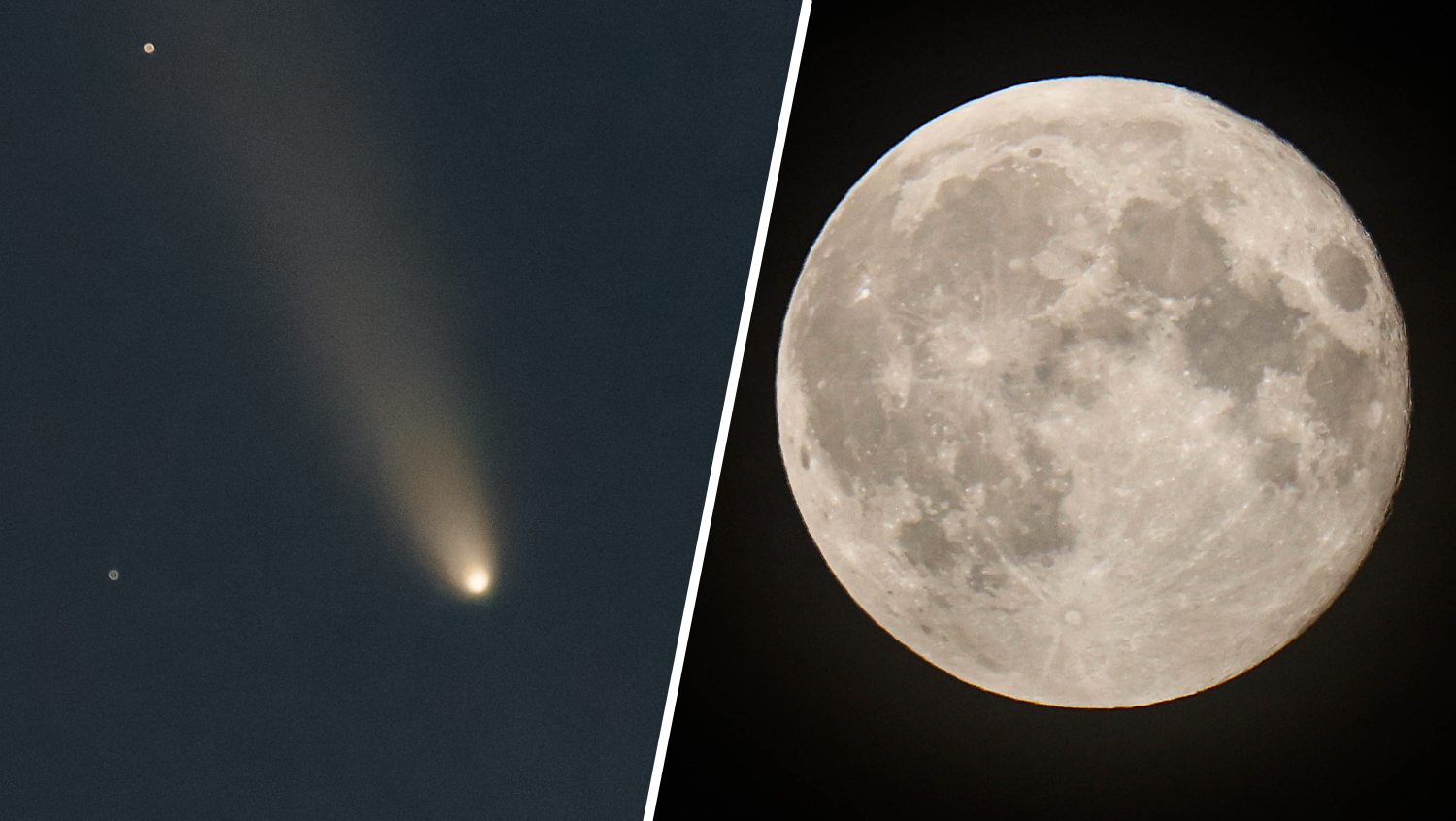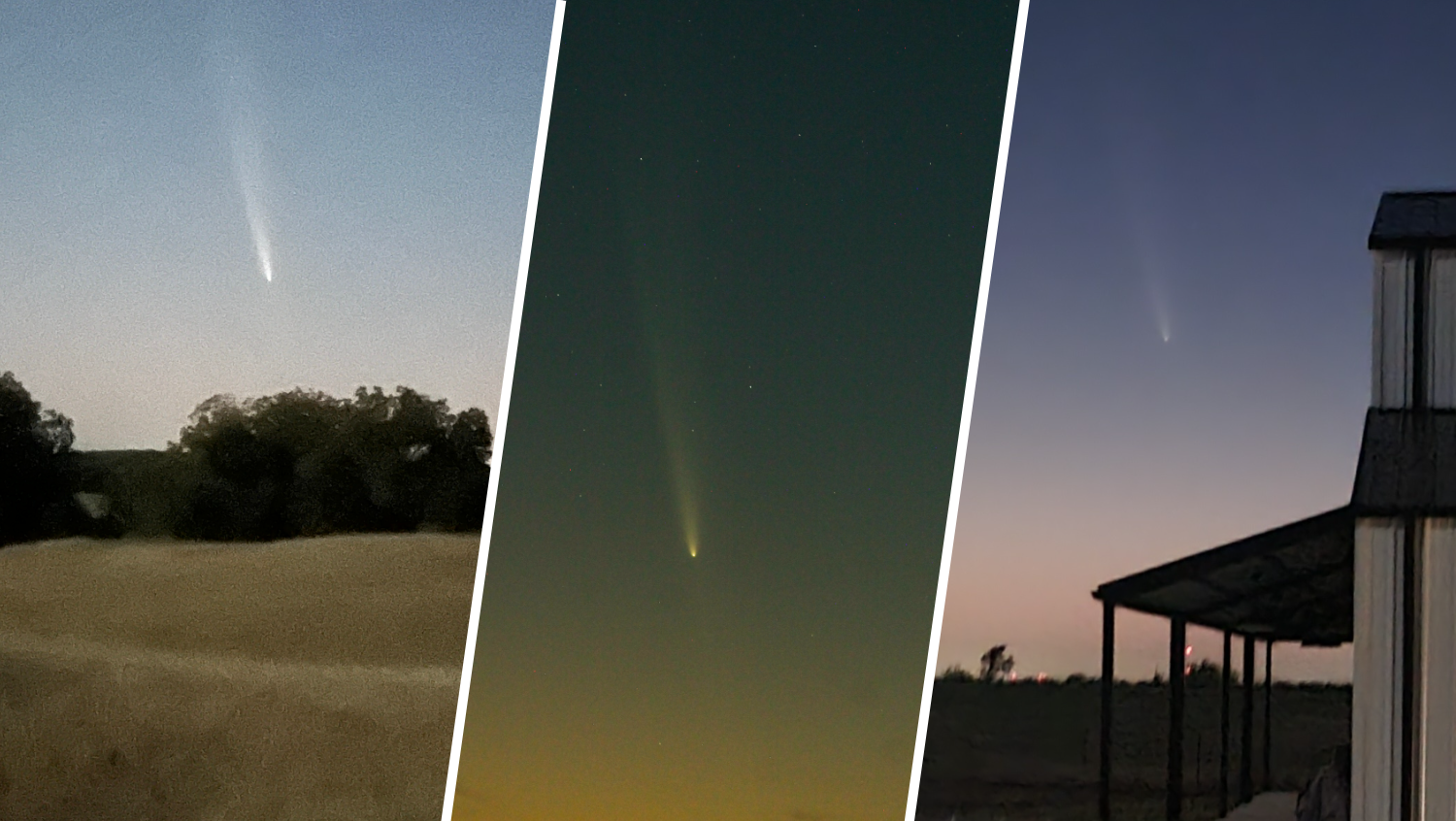
Stargazers in the Philadelphia region are in for a double celestial treat this week with a rare comet and a mega supermoon set to shine in the night sky.
"This could be a once-in-a-lifetime experience," Franklin Institute Chief Astronomer Derrick Pitts said of Comet Tsuchinshan-ATLAS appearing over the Philadelphia region this week. "So, take some friends out with you and enjoy the view."
The comet is shining brightest just as the Hunter's Moon supermoon shines even bigger than normal.
With all this excitement in the night sky, we have your guide to getting a glimpse of both Comet Tsuchinshan-ATLAS and the supermoon. Here are answers to your questions.
Get top local stories in Philly delivered to you every morning. Sign up for NBC Philadelphia's News Headlines newsletter.
Let's talk about Tsuchinshan-ATLAS first.
What is a comet?
"Comets are frozen leftovers from the formation of the solar system composed of dust, rock, and ices," NASA says. The comets are "snowballs of frozen gases, rock, and dust that orbit the Sun."
Comets "range from a few miles to tens of miles wide, but as they orbit closer to the Sun, they heat up and spew gases and dust into a glowing head that can be larger than a planet," NASA says. "This material forms a tail that stretches millions of miles."
Basically what you can see is that tail of heated up debris.
And there is no lack of comets out there waiting to be discovered.
"There are likely billions of comets orbiting our Sun in the Kuiper Belt and even more distant Oort Cloud," NASA says.
“Comets are more fragile than people may realize, thanks to the effects of passing close to the Sun on their internal water ice and volatiles such as carbon monoxide and carbon dioxide,” said NASA astronomer Bill Cooke, who leads the Meteoroid Environment Office at NASA’s Marshall Space Flight Center in Huntsville, Alabama.
NASA wrote in a Watch the Skies blog post:
The brightness of comets is measured on the same scale we use for stars, one that has been in use since roughly 150 B.C., when it was devised by the ancient scholar Hipparchus and refined by the astronomer Ptolemy. Stellar magnitude is measured on a logarithmic scale, which makes a magnitude 1 star exactly 100 times brighter than a magnitude 6 star. The lower the number the brighter the object, making it more likely to be clearly seen, whether by telescope or the naked eye.
“Typically, a comet would have to reach a magnitude of –6 to –10 to be seen in daylight,” Cooke said. “That’s extremely rare.”
No comet is arguably more famous than Halley's Comet that zips by earth every 75 to 76 years. "Halley is the only known short-period comet that is regularly visible to the naked eye from Earth, and the only naked-eye comet that can appear twice in a human lifetime," NASA says.
Where did Comet Tsuchinshan-ATLAS come from, how did it get its name?
This comet is much rarer than Halley's and might not come back, according to astronomers.
"The Oort Cloud comet, called C/2023 A3 Tsuchinshan-ATLAS, was discovered in 2023, approaching the inner solar system on its highly elliptical orbit for the first time in documented human history," NASA wrote in a Watch the Skies blog post. "It was identified by observers at China’s Tsuchinshan – or “Purple Mountain” – Observatory and an ATLAS (Asteroid Terrestrial-impact Last Alert System) telescope in South Africa. The comet was officially named in honor of both observatories."
The comet has likely been in orbit "upwards of 80,,000 years," according to Franklin Institute Chief Astronomer Derrick Pitts.
This might be a once in this world event as NASA updated its projections earlier this week: "the comet’s path may take it out of the solar system altogether."
When will the comet be visible?
The comet came within about 44 million miles of Earth on Oct. 12, 2024, NASA's Earth Observatory said.
Tsuchinshan-ATLAS first appeared low in west just after sunset in the early night sky on that Saturday, Pitts said in an Instagram reel. In the following evenings, it has moved higher into the sky and become more visible.
"At peak visibility in the northern hemisphere, Tsuchinshan-ATLAS’s brightness is estimated at between 2 and 4," Watch the Skies said. "In comparison, the brightest visible star in the night sky, Sirius, has a magnitude of –1.46. At its brightest, solar reflection from Venus is a magnitude of –4. The International Space Station sometimes achieves a relative brightness of –6."
As of Oct. 15, the comet had a magnitude of 3.3, NASA said.
With sunset at 6:19 p.m. Wednesday, the best time to head outside is between 6:50 p.m. and 7 p.m., NBC10 First Alert Weather meteorologist Bill Henley said. "Look toward the western horizon, where the comet will be setting."
The comet will continue to dim as it moves further from the sun each night and should be out of sight by early November, astronomers said.
“And savor the view,” Cooke advised.
What are the best conditions to view the comet?
"The head of the comet -- comprised of the nucleus and coma -- along with the tail should be visible again under clear, dark skies," Pitts said.
Grab a compass to get your bearings.
"Choose a dark vantage point just after full nightfall, Cooke recommended," NASA said. "Looking to the southwest, roughly 10 degrees above the horizon, identify the constellations of Sagittarius and Scorpio. Tsuchinshan-ATLAS should be visible between them. By Oct. 14, the comet may remain visible at the midway point between the bright star Arcturus and the planet Venus."
"Stars and comets will shine more brightly against the dark sky backdrop, making this a near-ideal opportunity to see the once-every-80,000-years comet," Henley said.
Pitts advises grabbing a pair of binoculars "to follow the comet along."
Henley agrees: "For the best view, try to find a spot away from city lights to minimize light pollution. While the comet may be visible to the naked eye, binoculars or a small telescope will give you a clearer and more detailed view, especially if you want to see its tail."
Now to that mega supermoon.
"Watch your back," Henley said. "In addition to the comet, you also want to check out the nearly full Hunter's Moon rising in the eastern sky. It will be the brightest supermoon of the year. While the moon won’t be fully illuminated until Thursday morning, it will still be a spectacular sight Thursday night, Happy viewing!"
What is a supermoon?
"The term 'supermoon' was coined in 1979 and is often used to describe what astronomers would call a perigean full moon: a full moon occurring near or at the time when the Moon is at the closest point in its orbit around Earth," NASA wrote.
"A supermoon occurs when the Moon’s orbit is closest (perigee) to Earth at the same time the Moon is full," NASA said.
Basically, it appears to be a bigger-than-usual full moon.
Why is this October supermoon so super?
Just all the names of this mega moon make it special. "The Next Full Moon is a Supermoon; the Hunter's Moon; the Travel Moon, the Dying Grass Moon, or the Sanguine or Blood Moon; the start of Sukkoth; Sharad Purnima, Kumara Purnima, Kojagari Purnima, Navanna Purnima Kojagrat Purnima, or Kaumudi Purnima; the end of Vassa and Pavarana; the Thadingyut Festival Moon; the end of the Phaung Daw U Pagoda Festival; and Vap Poya," NASA skywatcher Gordon Johnston wrote.
The third of 2024's supermoons will get within about 222,055 miles Wednesday night, making it seem even bigger and brighter than previous August and September supermoons.
"Scientists point out that only the keenest observers can discern the subtle differences," the Associated Press reported. "It’s easier to detect the change in brightness — a supermoon can be 30% brighter than average."
When is the best time to gaze at the October supermoon?
The moon officially becomes full on Thursday (Oct. 17, 2024) morning at 7:26 a.m. ET, NASA said. However, the moon will be a "supermoon," arrive at perigee at 8:48 p.m. ET on Wednesday.
The best times to see it in all its glory will be Wednesday night into Thursday morning before sunrise. Henley said the moon will rise in the east at 5:51 p.m. ET on Wednesday, Oct. 16.
However, it should "appear full for about three days around this time, from Tuesday evening through Friday morning," Johnston said.
Might the moon actually deter from the comet?
The moonlight will wash out some of the comet’s visibility, Cooke told the Associated Press.
“Most astronomers hate the full moon because its bright light messes up observing other objects. So it’s a bit hard for us to wax poetic about it even if it’s the biggest supermoon of 2024,” he said in an email.
The biggest question: Will the weather over the Philadelphia region cooperate for the celestial double feature?
Simple answer: yes!
"Over the next few evenings, the weather will be near perfect for catching a rare glimpse of the comet that's been lighting up the night sky," meteorologist Bill Henley said. "In the Philadelphia area, a large area of high pressure is building in, bringing us clear skies and cold nights. This will also reduce atmospheric moisture and particles, giving us a cleaner, crisper view of the night sky."
"Temperatures will drop into the 40s by the time the comet dips below the horizon at 8:32 p.m. on Wednesday, Oct. 16, 2024, so be sure to dress warmly," Henley said.
Don't worry if you miss the comet Wednesday night as Henley said the clear skies continue for the next several days.
Enjoy!
Sign up for our Breaking newsletter to get the most urgent news stories in your inbox.




